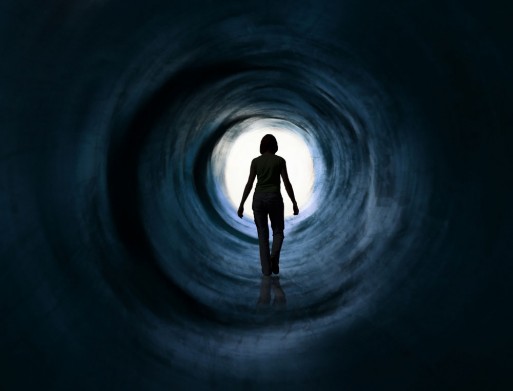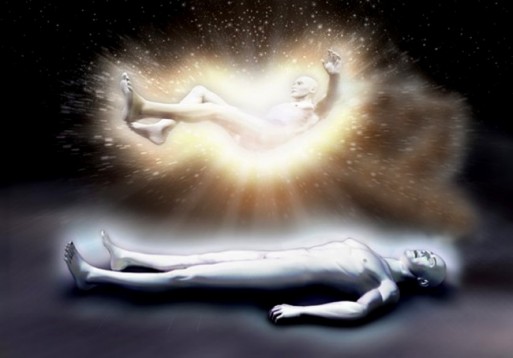In order to live, singer and songwriter Pam Reynolds first had to die. Her brain aneurysm required a surgery that lowered her body temperature to a risky 60 degrees Fahrenheit. Her heart stopped and her EEG brain waves dwindled into silence. While the doctors operated on her brain, she was clinically dead. But during the three hours of her operation, after which she was revived and declared to be in stable condition, she experienced anything but nothingness: an out-of-body experience (OBE) followed by a tunnel with warm, loving light, at the end of which waited her deceased friends, her grandmother and the realization that “her soul was part of God and that everything in existence was created from the light (the breathing of God).” Was it a hallucination? Did she witness what all of us will upon death—and then come back to tell us about it?
“Consider the implications of these uncanny experiences: the consciousness exists beyond the material brain. We are more than our physical selves. There may be an irrefutable afterlife.”
Whatever the explanation may be, Pam Reynolds embarked on a Near Death Experience (NDE). The term refers to any mystical, inexplicable and vivid experiences that a person receives when their body is materially and scientifically unable to receive sensory input. And the details of her journey are hardly singular: many cases (with an estimated 25 million NDEs worldwide in the past 50 years) describe the same OBE, cleansing light, omnipresent euphoria, and high levels of consciousness and clear thinking necessary to recall these phenomena. Religion, class and culture do not alter these basic similarities, and NDEs typically inspire profound and positive change in beliefs, values, behaviors, and worldviews” that all seem “quite comparable afterward.” Whether it is a quick vacation to the afterlife or the result of a few hitherto undetected buzzings in the brain, something universal is happening.
…continual failures serve to underscore the immaterial nature of NDEs, which causes scientists studying the phenomena to sound like curmudgeonly pedants without a clue.
Making sense of it, however, is highly controversial. Ever since Raymond Moody’s popular book Life After Life brought NDE to public attention in 1975, other researchers have sought to prove the physical mystery of NDE through “corroborated veridical NDE perceptions.” These include the details gleaned during an OBE, which can then be verified, as is the case for a woman named Maria. After entering cardiac arrest, this woman left her body and saw, in a remote location elsewhere in the hospital, a shoe which she then recounted in precise detail: a sneaker with a worn toe and one lace tucked under the sole. Her social worker went in search of this shoe, which Maria could not possibly have seen from where she was—and there the shoe was, exactly as described. Similar evidence comes from the NDEs of blind people, who suddenly gain the sense of vision during these metaphysical leaps out of the brain. Consider the implications of these uncanny experiences: the consciousness exists beyond the material brain. We are more than our physical selves. There may be an irrefutable afterlife.
NDEs seem better left as what they are—miraculous and inexplicable. Why explain the wonderful story away with cold, hard fact?
Nevertheless, materialistic scientists have tried again and again to explain the miracle away. You can find elsewhere a more elaborate summary of their arguments, but generally they ascribe the NDE experience to a particular region of the brain, to the effects of low oxygen on the occipital lobe, or to strange hallucinations similar to (and reproduced by) psychedelic drugs. But for various reasons, none of these fully answer the mystery behind the veridical NDE perceptions or the fact that patients can have vivid memories and feelings while their brains are not functional. The drive to discover the physical cause of NDEs is still productive; its continual failures serve to underscore the immaterial nature of the experience, which causes scientists studying the phenomena to sound like curmudgeonly pedants without a clue.
But the point in the first place is not to have a clue. Metaphysics exists beyond the realm of science, at least for now. NDEs seem better left as what they are—miraculous and inexplicable. Why explain the wonderful story away with cold, hard fact?
Have you ever had a Near Death Experience? How do you explain it? We look forward to your comments below.
Related SevenPonds Articles:
- How Can Afterlife Communication Aid The Grieving Process? An Interview With Terri Daniel
- Book Review: “Proof of Heaven” by Eben Alexander, M.D.
- Can Scientific Research Lead Us to the Spirit World?

 Near Death Experiences: Glimpses of Eternity or Funny Business in the Brain?
Near Death Experiences: Glimpses of Eternity or Funny Business in the Brain?





 How to Comfort A Dying Loved One
How to Comfort A Dying Loved One
 Our Annual Seven Holiday Gifts for Someone Who Is Grieving, 2024 Edition
Our Annual Seven Holiday Gifts for Someone Who Is Grieving, 2024 Edition














